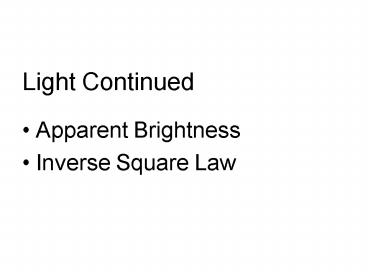Light Continued - PowerPoint PPT Presentation
1 / 17
Title:
Light Continued
Description:
2; naked eye limit is about 6. Sirius has mag. 1.5. ... Sirius A. 1. 26.7. Sun. Luminosity (compared to sun) Apparent magnitude. Distance (light years) ... – PowerPoint PPT presentation
Number of Views:153
Avg rating:3.0/5.0
Title: Light Continued
1
- Light Continued
- Apparent Brightness
- Inverse Square Law
2
Illusions
3
Illusions
4
Stellar Luminosity
Luminosity is the total amount of power the star
radiates into space. It is measured in power
units (Watts).
The apparent brightness is the amount of light
reaching us per unit area.
Brightness of a star in the sky depends on the
distance to a star and its luminosity.
5
Brightness of Stars
- True brightness (or luminosity) is a stars
actual rate of energy output, measured (for
example) in watts. The suns luminosity is about
4 x 1026 watts. - Apparent brightness is determined by the
intensity of starlight striking a detector. It
is measured (for example) in watts per square
meter. The suns apparent brightness from
earths location is about 1400 watts per square
meter.
True brightness
Formula Apparent brightness
4p(distance)2
6
Brightness of Stars
True brightness
Formula Apparent brightness
4p(distance)2
7
- The inverse square law is due to the dilution of
the light. At each radius you have the same total
amount of light going through the surface of an
imaginary sphere. Surface area of a sphere
increases by R2. - The light/area therefore decreases by 1/R2
8
Inverse Square Law
Light has 1/4 the intensity compared to a
distance of R
Light more concentrated
9
Magnitude system for brightness
- Smaller numbers imply brighter stars.
- Apparent magnitude is a measure of apparent
brightness. Antares has mag. 1 Polaris has mag.
2 naked eye limit is about 6. Sirius has mag.
1.5. - The faintest stars observed with HST are of
30th magnitudes. - A star of magnitude 1.00 is 2.5 times brighter
than a star of magnitude 2.00.
10
The Nearest Stars
11
The Brightest Stars(as viewed from earth)
12
Apparent Brightness
Apparent brightness obeys an inverse square law
with distance.
At the distance of Jupiter (__ A.U.), the Sun is
_______ times dimmer than on Earth.
13
Alpha Centauri
- How does the apparent brightness of Alpha
Centauri compare to the Sun? - Alpha Centauri radiates almost the same amount of
light as the Sun. - Distance to Sun 1.5 x 108 km (1 A.U.)
- Distance to Star 3.8 x 1013 km (4 ly)
- 1ly
63,000 A.U.
3.8 x 1013 km 1.5 x 108 km 252,000
14
Alpha Centauri
- Alpha Centauri it is located 252,000 times
further away from Earth than the Sun. - Inverse Square Law 1/distance2
- 1/(252,000)2
- Thus, its apparent brightness is 62.5 billion
times less than that of the Sun.
15
- Suppose we move the Sun to three times its
current distance. How much fainter will the Sun
appear?
Original distance
Original brightness
16
QUESTION
- QUESTION Two stars have the same luminosity, but
one is 2X further away from the earth. It will
appear - 1/4 as bright
- 1/2 as bright
- 2X brighter
- 4X brighter
- Repeat for the case that the second star is 2X
closer. Use choices from above.
17
- https//www.uwsp.edu/physastr/jore/astro311/lect1/
htmllect/278,7,Inverse Square Law - http//astro1.panet.utoledo.edu/anatoly/astr1010/
materials/lect15_04.ppt - http//departments.weber.edu/physics/schroeder/ast
ro/lectureslides/StarProperties.ppt

